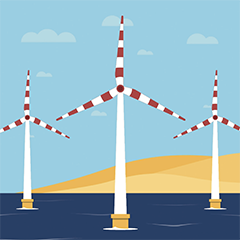If everything goes smoothly, then the UK’s offshore wind industry should be well on track to hit the Government’s target of 40 Gigawatts (GW) of generation capacity by 2030, but this is not an industry that’s accustomed to everything going smoothly. Chris Towner, Partner and renewable energy specialist at law firm Womble Bond Dickinson, looks at what needs to be done to ensure targets are hit.
The innovation and determination of the UK offshore wind sector has been proven time and again and has seen our windy little island become the undisputed world leader in offshore wind generation.
An optimistic assessment of the UK’s offshore wind capacity, including current generation capacity, around 10.4GW, projects that are ‘underway’, plus the, 8GW-worth of R4 projects, suggests that
we ought to hit the 40 GW/2030 target
with capacity to spare.
We saw more good news from our wind farms over the May 2021 bank holiday weekend as a new record for wind power generation was set in England, Scotland and Wales. Even if that relied on very strong wind conditions, it shows the capacity is there and we really are on the right track.
However, a pragmatic assessment of the task in hand would point to the many obstacles that remain in the way of these projects. If we have ambitions to hit the 2030 targets, and also to go beyond that and achieve net zero as a country by 2050, then many improvements must still be made to the way the industry operates, from project inception to completion.
And now is the time to start: with so many GW of generation still yet to be installed, here are some things to consider.
Can supply meet demand?
At the moment, there is greater demand for low carbon projects ready to invest in than there is supply, we need a regulatory regime that brings more clean energy innovation projects swiftly through the system, to attract this investment to the UK and help
to accelerate our decarbonisation goals.
The private sector is the key in all this, developers can deliver within the timescales, but only if a regime that enables this to happen is in place.
Consenting offshore wind projects
Key current concerns for projects include consenting risks, highlighted by the recent quashing of consent for Vattenfall’s Norfolk Vanguard offshore wind farm and certainty over the scale and timing of support from the Contracts for Difference (CfD) regime.
It’s no secret that securing consent for offshore wind farms is the most problematic aspect of the process. Project economics, technical constraints, supply chain capacity, social impact (aesthetics and amenity) and environmental impact must all be accounted for as part of the consenting process. It’s a complicated process that can cause significant delays, or cancellations, to projects as well as hugely increasing the risk for investors.



























